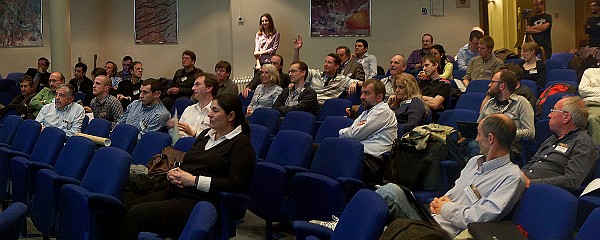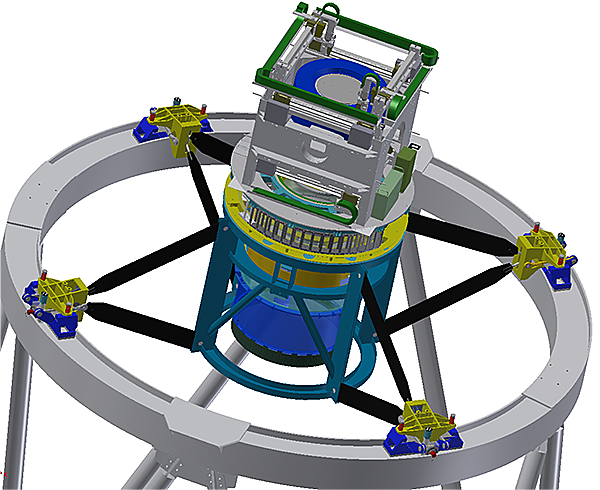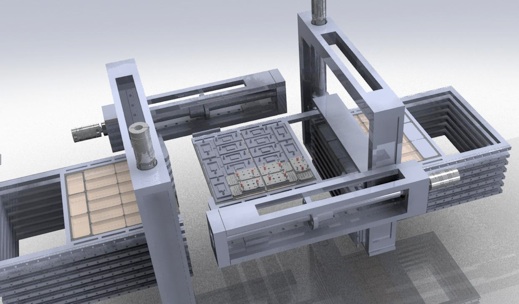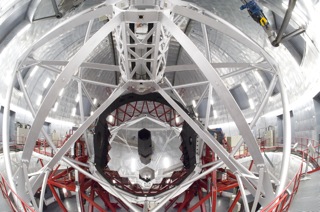Summary
|
A consensus has emerged amongst the partner countries that the
Isaac Newton Group of Telescopes (ING)
will play a crucial role in the partners' national
astronomy programmes over the next decade.
At the ING, we have worked closely with our user communities from the UK, the
Netherlands and Spain, and with our funding agencies
(STFC,
NWO and
IAC),
to agree on the scientific priorities and how to deliver them.
The
WHT
remains the focus of our strategy.
Until at least 2017, we will continue to offer classical observing,
and ING will continue to welcome visitor instruments at the WHT.
Several technical and operational enhancements are planned.
For example, we are
seeking approval of a new model for time allocation that introduces
long-term programmes through a common TAC.
From ~ 2015, users will have access to a new
visitor instrument,
PAUCam, an innovative imager designed to deliver
high-precision photometric redshifts over a wide field of view at WHT
prime focus.
ING's strategy for the rest of the decade
includes the development and deployment at the WHT of a
powerful wide-field multi-object spectrograph,
WEAVE.
First light is planned for 2017, and WEAVE will over the following ~
5 years carry out several ambitious spectroscopic surveys. A follow-up
of ESA's
Gaia mission, for example, will measure the radial velocities
of ~ 1 million stars, and is expected to revolutionise our
understanding of how the Milky Way was assembled.
A growing
partnership between ING and Grantecan should lead, over the next
few years, to a more efficient and
cost-effective operation on the mountain-top. This partnership also
opens up the possibility
of future UK/NL access to observing time on the
10-m
GTC.
|
The need for the ING telescopes
Thanks to the ING's creative user communities (and to
high-quality instrumentation on an excellent site),
the WHT and INT have been
very productive(1,2)
for over two decades.
To encourage the continuing
involvement of the ING communities in defining the scientific future
of the observatory over the next decade, a meeting
'Science with the WHT
2010 - 2020' was organised in London in March 2010, and users
were invited to express their views about future instrumentation
requirements at the telescope. Consultation with the communities continues
at a second meeting,
'Science
with the optical-infrared telescopes at CAHA and ORM in the coming
decade', in Madrid on 22-23 March 2012.

|
|
A workshop
"Science with the William Herschel Telescope 2010-2020",
was held in London in March 2010.
|
Two messages emerged from the 2010 London meeting.
Firstly,
there was strong support for providing a wide-field,
multi-object spectrograph (MOS), in particular for follow-up of
large-scale surveys from space missions such as
Gaia,
Herschel,
and
Euclid,
and from ground-based facilities such as
LOFAR,
UKIDSS,
VISTA,
and
DES.
There is significant involvement in all of these projects by astronomers
from the three ING communities.
Secondly, it
became clear at the London meeting that the demand for classical
observing will remain high in our communities for some time to come.
Diverse instrumentation, including novel visiting instruments, was
acknowledged as being a key ingredient in fostering original and
innovative science.
The WHT continues to be in high demand in the UK, the Netherlands and
Spain, with UK time over-subscribed by a factor of 2.7.
Key to the future demand is Northern-Hemipshere access, which the UK
and the Netherlands would lose without the WHT.
Northern-Hemisphere access is needed
for science requiring all-sky coverage (e.g.
Gaia
follow-up, or target-of-opportunity observations of unusual GRBs, SNe);
and to study specific Northern-Hemisphere targets, such as the
Kepler field, the Andromeda galaxy, other local-group galaxies, Milky
Way tidal streams, and the Virgo, Coma and Ursa Major clusters of
galaxies.
When the UK pulled out of
Gemini in 2013, the WHT
became the largest optical
telescope in the Northern Hemisphere to which UK astronomers have
guaranteed access.
For the Netherlands, both the WHT and INT will be important e.g., for
optical-infrared follow-up of
LOFAR
surveys.
For Spain, the WHT remains an essential general-purpose telescope
alongside the 10.4-m GTC.
WEAVE - a powerful new wide-field multi-object spectrograph for the WHT
Strong support for developing a northern wide-field MOS can be
found in several recent high-level reviews, including STFC's 2009
'Ground-based facilities review'
Astronet's
'Science vision for
European Astronomy' and
Astronet's
'Infra-structure roadmap'. In
general, wide-field MOS is thought to be a key area where 4-m telescopes
can contribute high-impact science in the era of 8-m telescopes (see
e.g. the
ETSRC report). With the demise of several other possible
MOS opportunities, the WHT is now the leading contender to host Europe's
most powerful MOS in the Northern Hemisphere, and this has enthusiastic
support from the three ING partners, and from ASTRONET.

|
|
Survey speed (number of
faint targets that can be detected at given S/N, per unit time) scales
as the product of primary mirror diameter D and solid angle W accessible
to a single observation. A 4-m telescope with a 2-degree FOV has 14
times the survey speed of a 10-m telescope with a FOV of 20 arcmin.
|
A large international
science team has now developed a compelling
science case for a powerful WHT MOS, to be called
WEAVE.
The case focuses on three major surveys, addressing:
(1) Milky Way archaeology
(Gaia follow-up, building on European strength in this area);
(2) galaxy evolution; and
(3) the nature of dark-energy.
The goals are summarised on the
WEAVE science page.
These surveys create a potential for
fundamental scientific contributions from the partner countries.
A consortium including UK, Dutch, Spanish and French
institutes is now in place to design and build WEAVE,
with funding secured up to and including preliminary design,
completed in mid-2014.
From 2017, a large fraction of WHT time
will be devoted to completing the three
planned surveys with WEAVE.

|
|
WEAVE at WHT prime focus: the new corrector (housed in the blue
section, above) delivers a 2-deg field of view.
The positioner (grey, above) comprises 2 sets of 1000 fibres, such that one
set can be configured while the other is used for observing.
Integral-field units can also be deployed in the focal plane.
The fibres feed a
dual-beam spectrograph
mounted on one of the WHT's Nasmyth platforms.
Two spectroscopic resolutions are available: R
~ 5000 for spectra covering the full optical range; and R ~ 20000 for
spectroscopy over restricted wavelength ranges.
|
ING 2013 - 2017
During the build-up to WEAVE, we plan to offer the WHT
with its current instrument suite, although there
may be some rationalisation of the facility instruments, focusing resources
on those which are most scientifically productive.
Some upgrades of the facility
instruments are already planned, e.g. a new red-sensitive,
low-fringing CCD for the AF2 prime-focus multi-fibre spectrograph.
The
science delivered by the WHT during 2013 - 2017 is likely to cover a
broad range of topics prominent in e.g. Astronet's
'Science vision for
European Astronomy',
from exoplanets to dark energy,
reflecting both
recent successes and upcoming
opportunities.
Examples of new scientific opportunities include: the
the discovery of exoplanet candidates
by Kepler and
SuperWASP;
the need for pilot studies for Gaia;
the possibility of
carrying out wide-field redshift surveys
(PAUCam)
for
DES and
Euclid;
the
LOFAR
survey and its
Transients Key Science Project;
the dramatic rise in the number of supernovae being
discovered, by
Pan-STARRS and the
Palomar Transient Factory; and a
likely increase in the rate of gamma-ray burst discovery when SWIFT's
successors come online.
ING will
encourage the three partners to contribute to a common pool of observing
time for long-term programmes.
This would comprise a fraction of the time due to each of the
partner countries, and
would be allocated by a common time-allocation committee (TAC). The
remainder of the time would be allocated by the existing national TACs.
After the WEAVE surveys begin in 2017, and depending on community
demand, some fraction of WHT time may continue to be available
to ING users
for observing with other facility instruments
(or for non-survey WEAVE observations).
Visiting instruments
The WHT plays a key role in instrument
innovation and development in the laboratories and universities
of the partner countries.
Bringing a private instrument to the WHT is
more straightforward than doing so at e.g. VLT, and during a typical
semester, ~ 6 visitor instruments are deployed at the WHT. Recent
examples includes
EXPO,
FASTCAM,
GHaFaS,
PNS,
SAURON and
ULTRACAM.
The
visitor instruments deliver ~ 20% of the WHT's scientific impact.
The
WHT is also a testbed for technologies to be deployed at
E-ELT, with
Durham's
CANARY, prototyping the wide-field laser-guide-star
tomography to be used in E-ELT EAGLE, currently deployed on
one of the WHT's Nasmyth platforms.
During 2013 - 17, ING will continue to extend
a welcome to visitor instruments.
PAUCam
In 2015, a new visitor instrument,
PAUCam, will arrive
at the WHT.
PAUCam will be mounted at WHT prime focus, and is an 18-CCD
wide-field imager equipped
with 36 narrow-band filters (and a set of
broad-band filters), designed to deliver photometric redshifts z with
accuracy δz~ 0.0035 (1 + z), across a wide field of view. The camera
will be used by the PAUCam consortium to carry out a large survey (~ 100 nights)
aimed at constraining the dark-energy equation of state via measured
redshift-space distortions. PAUCam will be available to the ING user
communities through the usual time-allocation committees.

|
|
PAUCam's filter-tray system, showing a tray inserted
in the focal plane, just in front of the CCD.
|
Student training
The role of the WHT and INT in student training is
highly regarded in all three partner countries.
Many UK, Dutch and Spanish PhD and MSc theses are based on
data from ING telescopes.
In the UK alone, since 2009, 53 PhD theses based wholly or in
part on ING data have been completed, or are in progress. The proximity of
the telescopes to Europe also allows students to get hands-on experience
of observing in a way which is not possible at most larger telescopes.
The
resident-studentship programme at the INT is also highly
regarded. Over the last 10 years,
40 students have each spent a year working on La Palma
as INT support astronomers, thereby acquiring a broad range of
observational, technical and support skills.

|
|
Student support astronomers are responsible for afternoon setup of the
instrument (above, setting up the IDS), as well as night-time support.
|
ING and GTC
The ING is enthusiastic about the arrival
at the Observatorio del Roque de los Muchachos (ORM)
of the 10.4-m
GTC
With superb optics and state-of-the-art
engineering, the GTC offers unprecedented potential for discovery
at our superb site, and keeps the ORM in the first rank of world
observatories.

|
|
The 10.4-m GTC, the largest single optical telescope in the world,
began science observations in 2009.
|
ING and GTC have agreed on a framework for technical
collaboration between their two highly-qualified teams. This will
likely grow in the coming years to fully exploit the benefits of
technical and scientific synergies between the two organisations.
Down the line, this partnership also opens up the possibility for the UK/NL
to access observing time on GTC, currently shared by the GTC partners
Spain, Mexico and the University of Florida. It's a time of change at
El Roque, and the ING aims to take a lead in exploiting for our partners
the best observational opportunities that arise.
References
(1) Benn C.R. & Sanchez S.F., 2001
PASP 113, 385,
'Scientific impact of large telescopes'
(2) Trimble V. & Ceja J.A., 2010,
Astron. Nachr. 331, 338,
'Productivity and impact of astronomical facilities: a recent sample'



